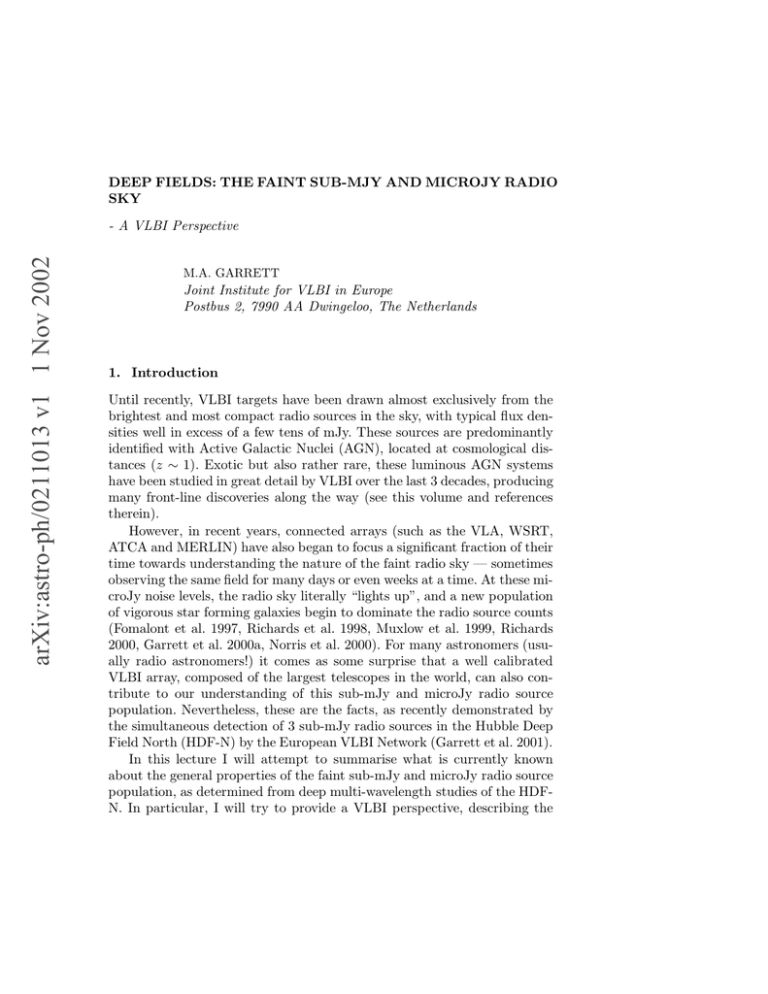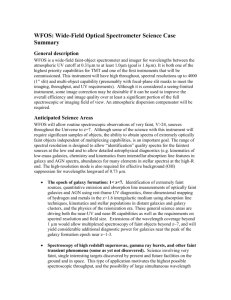DEEP FIELDS: THE FAINT SUB-MJY AND MICROJY RADIO SKY
advertisement

DEEP FIELDS: THE FAINT SUB-MJY AND MICROJY RADIO SKY arXiv:astro-ph/0211013 v1 1 Nov 2002 - A VLBI Perspective M.A. GARRETT Joint Institute for VLBI in Europe Postbus 2, 7990 AA Dwingeloo, The Netherlands 1. Introduction Until recently, VLBI targets have been drawn almost exclusively from the brightest and most compact radio sources in the sky, with typical flux densities well in excess of a few tens of mJy. These sources are predominantly identified with Active Galactic Nuclei (AGN), located at cosmological distances (z ∼ 1). Exotic but also rather rare, these luminous AGN systems have been studied in great detail by VLBI over the last 3 decades, producing many front-line discoveries along the way (see this volume and references therein). However, in recent years, connected arrays (such as the VLA, WSRT, ATCA and MERLIN) have also began to focus a significant fraction of their time towards understanding the nature of the faint radio sky — sometimes observing the same field for many days or even weeks at a time. At these microJy noise levels, the radio sky literally “lights up”, and a new population of vigorous star forming galaxies begin to dominate the radio source counts (Fomalont et al. 1997, Richards et al. 1998, Muxlow et al. 1999, Richards 2000, Garrett et al. 2000a, Norris et al. 2000). For many astronomers (usually radio astronomers!) it comes as some surprise that a well calibrated VLBI array, composed of the largest telescopes in the world, can also contribute to our understanding of this sub-mJy and microJy radio source population. Nevertheless, these are the facts, as recently demonstrated by the simultaneous detection of 3 sub-mJy radio sources in the Hubble Deep Field North (HDF-N) by the European VLBI Network (Garrett et al. 2001). In this lecture I will attempt to summarise what is currently known about the general properties of the faint sub-mJy and microJy radio source population, as determined from deep multi-wavelength studies of the HDFN. In particular, I will try to provide a VLBI perspective, describing the 2 M.A. GARRETT Figure 1. Close-up of a small region of the HDF-N (Williams et al. 1996). More distant galaxies also tend to be more morphologically disturbed (NASA/STScI). One of the radio sources (VLA J123644+621133) detected by the European VLBI Network is circled (see section 4). first deep, wide-field, VLBI pilot observations of the HDF, together with a summary of the main results. The role VLBI can play in future high resolution studies of faint radio sources will also be addressed. 2. The Hubble Deep Field and Galaxy Formation The Hubble Deep Field North (HDF-N) is one of the most important, publicly available resources ever generated in the history of astronomy (see Ferguson, Dickinson & Williams 2000 and references therein). What initially appeared to be a small, undistinguished 2.50 × 2.50 patch of the celestial sphere was transformed during a 10-day long Hubble Space Telescope (HST) deep field integration (Williams et al. 1996). The key advance of the HDF images was not only the depth which they reached (I < 29m ) but perhaps more crucially, the superb angular resolution that accompanied them. On inspection it immediately became clear (see Fig. 1), that the most distant galaxies in the field were also the most morphologically disturbed. For example, familiar “grand design” spirals observed locally, all but disappear beyond z ∼ 0.3. In terms of morphology, these distant, disturbed systems are most akin to nearby Ultra Luminous Infrared Galaxies (ULIG) and interacting starburst systems (Abraham & van den Bergh 2001). THE FAINT RADIO SKY 3 Figure 2. Multi-wavelength images of the HDF-N in the radio (Garrett et al. 2000a – includes the HFF), sub-mm (Hughes et al. 1998), Mid-IR (Rowan-Robinson et al. 1997 – includes part of the HFF) and x-rays (Brandt et al. 2001 -includes the HFF). 2.1. MULTI-WAVELENGTH FOLLOW-UP OBSERVATIONS OF THE HDF The HDF represented a huge investment in HST observing time, and this was matched by an equally ambitious multi-wavelength follow-up campaign. The latter included every part of the e-m spectrum accessible via both ground and space based instrumentation. In many cases, extremely long integrations produced the very deepest view of the Universe in a given waveband. In addition, extensive efforts were made to obtain spectroscopic and photometric redshifts of sources in the field (including the adjacent Hubble Flanking Fields – HFF). A pictorial summary of a limited subset of these multi-wavelength follow-up observations is shown in Fig 2. It comes as no surprise that the source counts in the HST images (both in the optical and Near-IR) are considerably greater than that observed at other wavelengths. What is surprising, however, is that despite this fact, a considerable fraction (10-20%) of the faint radio, Mid-IR and x-ray detections, appear to be heavily obscured in the optical i.e. they have no obvious optical counterparts (R> 25m ). An even larger fraction of the faint SCUBA source population fall into this category, suggesting that the submm observations reveal a completely different (unobscured) view of the high redshift, dusty, star-forming Universe (Hughes et al. 1998). We will return to the nature of these faint sub-mm sources in section 3.3. 3. Deep Radio Imaging of the HDF In order to detect even a handful of radio sources in the HDF-N, noise levels of a few microJy must be achieved. These in turn require integration times ranging from a few days – in the case of the WSRT and VLA, to many days in the case of MERLIN. 4 M.A. GARRETT Figure 3. The WSRT 1.4 GHz contour map of the HDF (see incomplete rotated square) and part of the HFF superimposed upon a deep CFHT optical image of the HDF region made by the Canada-France-Hawaii telescope (courtesy Amy Barger). Crosses indicate previously known VLA detections, boxes indicate new WSRT detections. The detection of a nearby, extended star forming galaxy is highlighted (upper left). 3.1. VLA 8.3 GHZ, VLA-MERLIN & WSRT 1.4 GHZ OBSERVATIONS Deep VLA observations of the HDF (including the HFF) have been conducted at both 8.3 and 1.4 GHz (Fomalont et al. 1997, Richards et al. 1998, Richards 2000). The 8.3 GHz observations reach noise levels of a few microJy per beam (several times better than the 1.4 GHz observations) but more sources are actually detected at 1.4 GHz where the source counts are steeper and the VLA field of view wider. Perhaps the most “complete” radio view of the HDF (see Fig. 3) is provided by the WSRT 1.4 GHz observations (Garrett et al. 2000a). These are sensitive to very extended radio structures, although for the WSRT (and indeed the VLA), the vast majority of the microJy radio source population remain barely or completely unresolved at arcsecond resolution. Combined VLA-MERLIN 1.4 GHz observations with a resolution of 0.200 (Muxlow et al. 1999) begin to resolve most of these sources but the detailed morphology of the microJy radio source population still remains unknown. The main results of the VLA, MERLIN and WSRT data can be summarised as follows: − Most of the radio sources are identified with relatively bright (R < 25m ), moderate redshift, optical counterparts – often identified as in- THE FAINT RADIO SKY − − − − − − 5 teracting, irregular or peculiar morphological type (Richards et al. 1998) The 1.4 GHz VLA source sample is steep spectrum in nature (typically α ∼ −0.85 – Richards 2000). Sources selected by the VLA at 8.3 GHz are significantly flatter specutrum (α ∼ −0.35) There is a strong correspondence between the Mid-IR ISO detections and the radio detections (see Fig. 4 right). Indeed the majority of radio sources (after applying appropriate k-correction factors) appear to closely follow the FIR-radio correlation (Garrett 2002). Of the 91 sources detected with the combined MERLIN-VLA 1.4 GHz array (see Fig. 4 left), the majority show radio structure on sub-galactic scales (Muxlow et al. 1999). About 50% of the MERLIN-VLA 1.4 GHz detections show extended structure aligned with the optical isophotes of the galaxy. The WSRT detects a small but significant population of both star forming galaxies and AGN, some of which are resolved by the higher resolution VLA and MERLIN observations (Garrett et al. 2000a; Muxlow priv. comm). A comparison between the VLA and WSRT 1.4 GHz images (separated by several years) shows evidence for significant variability (factors of 2 or more) for a few percent of the sub-mJy radio source population (presumably low-luminosity AGN). Around 10-20% of the microJy source population (see Fig. 4 -left and Richards et al. 1999) are optically faint or completely unidentified (R > 25m ). 3.2. SUMMARY OF RESULTS These results, in particular the general correlation between radio and FIR luminosity, suggest that the radio emission arising in the faint sub-mJy and microJy radio source population is largely associated with massive star formation in distant star forming galaxies. However, a significant fraction of all the sub-mJy sources (∼ 30%) are also identified with low-luminosity AGN. The remaining 10-20% of the faint radio source population are assoiciated with either extremely faint (R > 25) optical identifications, or remain unidentified altogether - even in the HDF-N itself (I > 28). Note that these conclusions are dominated by the faintest (and therefore more numerous) microJy radio sources – for example, the AGN fraction increases rapidly at higher (sub-mJy) flux density limits. In addition, simply labeling sources as pure “starbursts” or pure “AGN” is a little misleading; it is quite possible (even likely) that both phenomena co-exist in some of these faint systems. When we label sources in this way, we are only identifying 6 M.A. GARRETT Figure 4. Left: MERLIN-VLA contour map (super-imposed on the HST gray-scale image) of J123651+621221 – an optically faint dust-obscured starburst system in the HDF with a total flux density of 49µJy (Muxlow et al. 1999). (b) Right: The strong correlation between FIR and radio luminosity for high-z galaxies detected by both ISO and the WSRT in the region of the HDF-N (Garrett 2002) the dominant phenomenon that gives rise to the bulk of the observed radio emission. Studies of nearby (nuclear) starburst galaxies such as M82 and Arp 220 give us some idea of how the radio emission arises in these star forming galaxies. According to conventional theories, the chief ingredients are supernova (SN) events associated with massive star formation (see Marcaide this lecture series), and in particular, the global acceleration of cosmic ray electrons via shocks associated with these events. The total radio luminosity of a “normal” galaxy is therefore a direct measure of the SN event rate, and in turn, the star formation rate (SFR) of massive stars (e.g. Condon 1992). In this scenario, the tight correlation between the FIR and radio luminosity of star forming galaxies is explained by the FIR emission arising from the absorption and re-radiation (via dust) of the intense uv emission also associated with massive stars. By assuming an Initial Mass Function (e.g. a Salpeter IMF) for the stellar population, and some scaling factors based on local observations of the Milky Way, radio observations provide unbiased estimates of the SFR that are largely unaffected by extinction due to dust. The SFR inferred in this way for M82 and Arp 220 are ∼ 10 and 100 M /yr respectively. The levels of radio and FIR emission observed for the more most distant radio sources in the HDF implies much higher star formation rates: ∼ 1000 M /yr. THE FAINT RADIO SKY 7 3.3. THE OPTICALLY FAINT MICROJY RADIO SOURCE POPULATION There is now good evidence to suggest (e.g. Barger et al. 2000; Chapman et al. 2001) a close correspondence between the optically faint microJy radio sources and the faint (SCUBA) sub-mm source population. The bulk of the observational evidence suggests that these sources are located at cosmological distances, and are enveloped in thick, opaque dust. Since it is estimated that a substantial fraction of the total radiation in the Universe is emitted from these obscured systems, the detailed nature of these sources is a key topic in astronomy today. However, the study of these dusty systems is severely hampered by the fact that they are so difficult to detect in almost all wave-bands, except the sub-mm and radio domains. It is thought that the sub-mm emission is associated with FIR emission (again absorption and re-radiation of uv emission by dust) that is redshifted into the sub-mm wavelength range. However, the source of the original uv emission is unclear – it could be generated purely by massive stars in dense star forming regions, purely by embedded AGN, or some mixture of both phenomena. Similarly in the radio, it is not known whether the synchrotron emission is generated by massive star formation processes or by accretion associated with a central AGN. As we have seen, if massive star formation is responsible, radio flux densities imply SFRs ∼ 1000 M /yr, and an inferred global SFR that is completely “at odds” with previous optical and ultraviolet studies (Haarsma et al. 2001, and references therein). Distinguishing between the AGN and starburst phenomena in these systems is clearly of fundamental importance. In the radio, only VLBI provides sufficient angular resolution to distinguish between the two cases. In particular, radio emission generated by star formation processes should be resolved by current (sensitivity limited) VLBI observations. AGN, on the other hand, should remain considerably more compact and readily detectable. 4. Deep Field VLBI observations of the HDF On 12-14 November 1999 the EVN conducted the first “pilot” VLBI “blank field” observations of the radio sky. The field chosen was the HDF-N – an area that is just about as “blank” and undistinguished as the radio sky gets. The brightest source in the ∼ 2 arcminute radial field of view was an FR-I radio galaxy with a total WSRT 1.4 GHz flux density of ∼ 1.6 mJy. The data were recorded at a rate of 256 Mbits/sec for 32 hours – a sustained capability that is unique to the EVN (and has recently been extended to 512 Mbits/sec). Observing in phase-reference mode, a total of ∼ 14 hours of “on-source” data were collected. With a resolving beam area 1 million times smaller than the WSRT HDF-N observations (see sec- 8 M.A. GARRETT PLot file version 3 created 15-OCT-2001 16:35:49 CONT: HDF IPOL 1653.990 MHZ HDF NA CLN.ICL001.1 CONT: HDF IPOL 1653.990 MHZ HDF NA CLN.ICL002.1 CONT: HDF IPOL 1653.990 MHZ HDF NA CLN.ICL003.1 62 11 33.22 62 14 04.78 33.20 04.76 62 13 31.50 33.18 33.12 33.10 DECLINATION (J2000) 33.14 04.74 DECLINATION (J2000) DECLINATION (J2000) 33.16 31.45 31.40 04.72 04.70 04.68 04.66 33.08 04.64 33.06 31.35 04.62 33.04 04.60 33.02 12 36 44.398 44.39644.39444.39244.39044.38844.38644.38444.382 RIGHT ASCENSION (J2000) Cont peak flux = 3.1686E-04 JY/BEAM Levs = 3.000E-05 * (-3, 3, 4, 5, 6, 7, 8, 9) 12 36 42.10 42.09 42.08 RIGHT ASCENSION (J2000) Cont peak flux = 2.1953E-04 JY/BEAM Levs = 3.000E-05 * (-3, 3, 4, 5, 6, 7, 8, 9) 12 36 46.34 46.33 RIGHT ASCENSION (J2000) Cont peak flux = 1.5930E-04 JY/BEAM Levs = 3.000E-05 * (-3, 3, 4, 5, 6, 7, 8, 9) 46.32 Figure 5. EVN detections in the HDF: the distant z=1.01 FRI (left), the z=4.4 dusty obscured starburst hosting a hidden AGN (middle) and the z=0.96 AGN spiral (right). tion 3), the EVN imaged an area of about 12 arcmin2 . Six HDF-N radio sources were thus targeted simultaneously (using wide-field imaging techniques – see Garrett et al. 1999). The final naturally weighted images have an r.m.s. noise level of ∼ 33 µJy/beam – much larger than that expected from thermal noise considerations (∼ 11 µJy/beam). The images are probably limited by the inclusion of poorly calibrated or completely corrupt data - difficult to identify in this case, simply by inspection. Nevertheless, the EVN simultaneously detected three radio sources above the 165 µJy (∼ 5σ) limit, in the inner part of HDF-N region (see Fig 5). These include: VLA J123644+621133 (a z = 1.013, low-luminosity and extremely distant FR-I radio source which is resolved by the EVN into a core plus hot-spots associated with the larger scale jet), VLA J123642+621331 (a dust enshrouded, optically faint, z = 4.424 starburst system – Waddington et al. 1999) and the faintest detection, VLA J123646+621404 (a face-on spiral galaxy at z = 0.96 with a total EVN flux density of 180 µJy/beam). The diversity of optical type is interesting but the real surprise is the detection of a radio-loud AGN in the dust obscured, z = 4.4, starburst system. This argues that at least some fraction of the optically faint radio source population harbour hidden AGN (this may be similar to the same obscured population detected by Chandra). These AGN powered systems might be quite difficult to detect with SCUBA, assuming the dust temperatures are higher than that associated with pure star forming systems. In any case, the detection of this system highlights the use of VLBI as a powerful diagnostic – able to distinguish in principle (via brightness temperature arguments) between radio emission generated by nuclear starbursts and AGN. 5. Future Prospects for deep, wide-field VLBI studies The EVN observations of the HDF suggest that deep, wide-field VLBI studies are not only possible, but in principle they can deliver important THE FAINT RADIO SKY 9 Figure 6. A small portion of the NOAO-DWFS with a shallow WSRT 1.4 GHz contour map superimposed (image courtesy of Raffaella Morganti, de Vries et al. 2001, first radio contour at 30µJy/beam). The dashed circle shows the FWHM of a 70-m telescope primary beam. Assuming modest r.m.s. noise levels of ∼ 10 µJy/beam, 5 (6σ) target fields (of extent 20 × 20 ) can be identified. These fields are all located within the primary beam, and can be correlated simultaneously, and mapped out in their entirety. A (faint) VLBI calibrator to the North of the field permits accurate and continuous phase calibration to be applied to the target fields. astronomical results. So far we have only scratched the surface. In a sense, we are just beginning to appreciate the fact, that VLBI has reached a sensitivity level where we can expect to detect many discrete radio sources in a single field of view (irrespective of where you point the telescopes!). This is quite a departure from the traditional role of isolated VLBI observations of very compact, and often very bright radio sources. In the short term the use of in-beam phase-calibration techniques (Fomalont et al. 1999) should permit us to reach the expected thermal noise level of only a few microJy/beam (assuming a global VLBI array operating at 256 Mbits/sec and an on-source integration time of 24 hours). The real advance, however, will be in making full use of the raw data i.e to map out the primary beam response of individual VLBI elements in their entirety. Simultaneous multiple-field correlation, coupled with incredibly fast data output rates, is now being pursued at the EVN MkIV Data Processor at JIVE. When complete, this development will provide astronomers with the ability to image dozens of faint sub-mJy radio sources – all observed simultaneously with microJy sensitivity, full uv-coverage and milliarcsecond resolution (Garrett 2000b). Fig. 6 summarises the concept of deep, in-beam, 10 M.A. GARRETT wide-field VLBI but with current sensitivity limits employed. Large areas of the sky (such as that shown in Fig. 6) are now being routinely surveyed in great detail by optical and near-IR instruments. These deep surveys (e.g. the NOAO Deep Wide-Field Survey, Januzi & Dey 1999) have the great advantage that they cover enormous areas of sky (many square degrees) and thus there is always some region of the survey area that will include an appropriate “in-beam” VLBI calibrator. What fraction of these target sources can be detected ? The HDFN results suggest that about 1/3 of the targets in a randomly selected field will be AGN, and that most of these will have compact structure. The remaining distant starburst systems will most likely be resolved by VLBI (even with microJy sensitivity) – detecting and imaging these systems with VLBI scale resolution, must await the construction of a much more sensitive, next generation radio telescope, such as the SKA (see Lecture by A. Kus, this volume). Nevertheless, I suspect that by the time we return to Castel St. Pietro Therme for the next NATO-ASI school, the use of VLBI as a deep, wide area survey instrument will already be well established. References Abraham, R.G. & van den Bergh, S. 2001, Science, 293, p. 1273-1278. Barger, A.J., Cowie, L.L. & Richards, E.A. 2000, AJ, 119, 2092. Brandt, W.N., Alexander, D.M., Hornsheimeier, A.E., et al. 2001, AJ, 122, 2810. Condon, J.J. 1992, ARA&A, 30, 575 Chapman, S.C., Richards, E.A., Lewis, G.F., Wilson, G., & Barger, A.J. 2001, ApJ, 548, L147. de Vries, W.H., Morganti, R., Rottgering, H.J.A. et al. 2002, AJ submitted (astroph//0111543) Ferguson, H.C., Dickinson, M.W, Williams, R. 2000, ARA&A, 38, pp. 667-715. Fomalont, E.B., Kellermann,K.I., Richards, E.A., Windhorst, R.A. & Patridge, R. B. 1997, ApJ Letters, 475, L5. Fomalont, E.B., Goss, W.M., Beasley, A.J. & Chatterjee, S. AJ, 117, 3025. Garrett, M.A., Porcas, R.W., Pedlar, A. et al. 1999, NewAR, 43, 519 (astro-ph/9906108). Garrett, M.A., de Bruyn, A.G., Giroletti, M., Baan, W.A., Schilizzi, R.T. 2000a, A&A Letters, 361, L41 (astro-ph/0008509). Garrett, M.A. 2000b, Procs. of the VSOP Symposium, Eds.: H. Hirabayashi, P.G. Edwards, and D.W. Murphy, Published by the ISAS, pp 269-272 (astro-ph/0003073). Garrett, M.A., Muxlow, T.W.B., Garrington, S.T. et al. 2001, A&A Letters, 366, L5 (astro-ph/0008509). Garrett, M.A., 2002, A&A Letters, in press (astro-ph/0202116). Haarsma, D.B., Partridge, R.B., Windhorst, R.A., Richards, E.A. 2000, ApJ, 544, 641. Hughes, D.H., Serjeant, S., Dunlop, J., Rowan-Robinson, M., et al. 1998, Nature, 394, 241. Januzi, B.T. and Dey, A. BAAS, 31, 1392. Muxlow, T.W.B., Wilkinson, P.N., Richards, A.M.S., et al. 1999, NewAR, 43, 623. Norris, R.P, Hopkins, A., Sault, R.J., et al. 2000, Procs. of the ESO workshop – Deep Fields, eds. Cristiani, Renzini & Williams, Springer pp 135-138. Richards, E.A., Kellermann, K.I., Fomalont, E.B., et al. 1998, AJ, 116, 1039. Richards, E.A., Fomalont, E.B., Kellermann, K.I. et al. 1999, ApJ, 526, L73. THE FAINT RADIO SKY 11 Richards, E.A. 2000, ApJ, 533, 611. Rowan-Robinson, M., Mann, R.G., Oliver, S.J. et al. 1997, MNRAS, 289, 490. Waddington, I., Windhorst, R.A, Cohen, S.H., Partridge, R.B. Spinrad, H. & Stern, D. 1999, ApJ Letters, 526, L77. Williams, R.E., Blacker, B, Dickinson, M. et al. 1996, AJ, 112, 1335.




